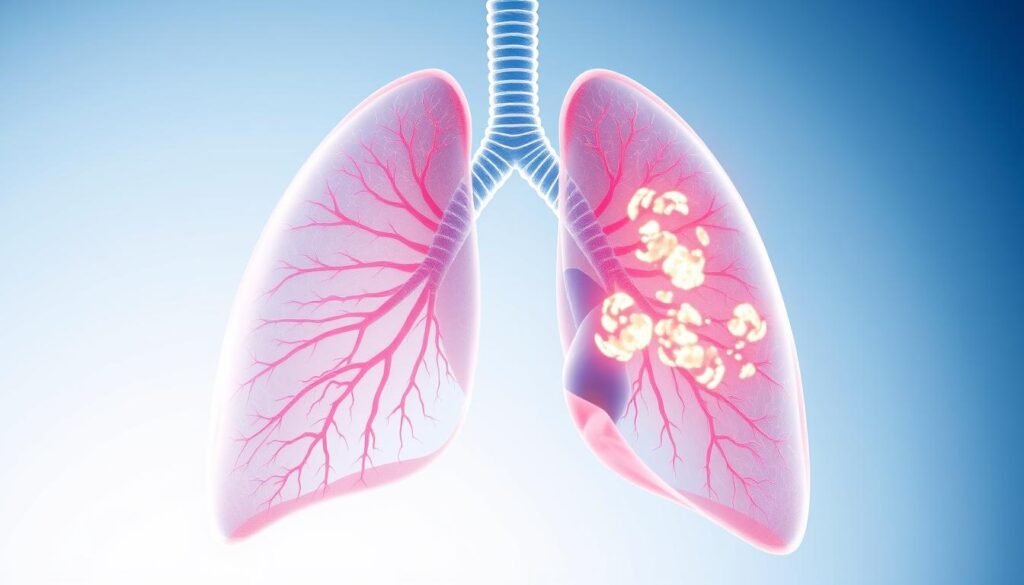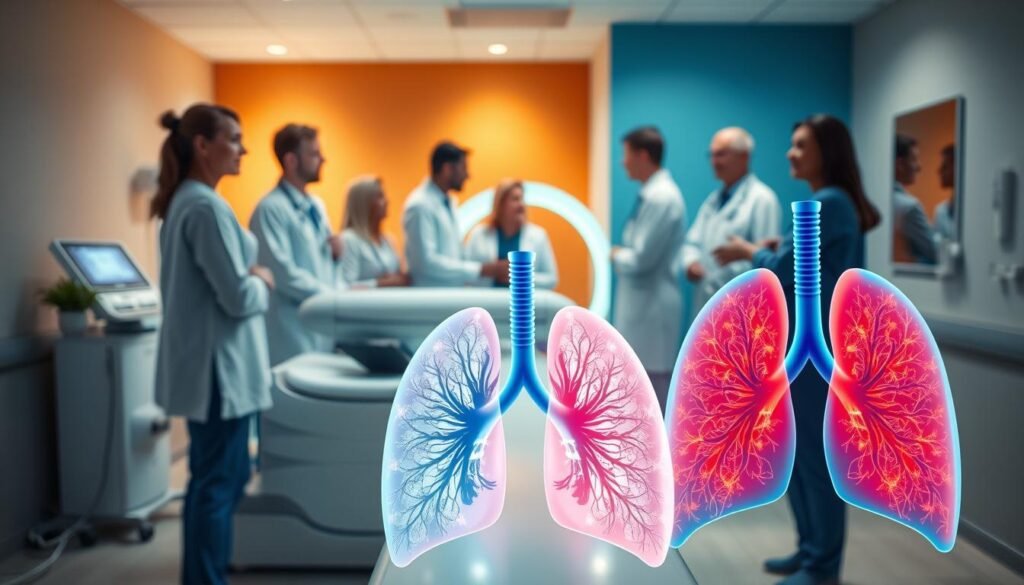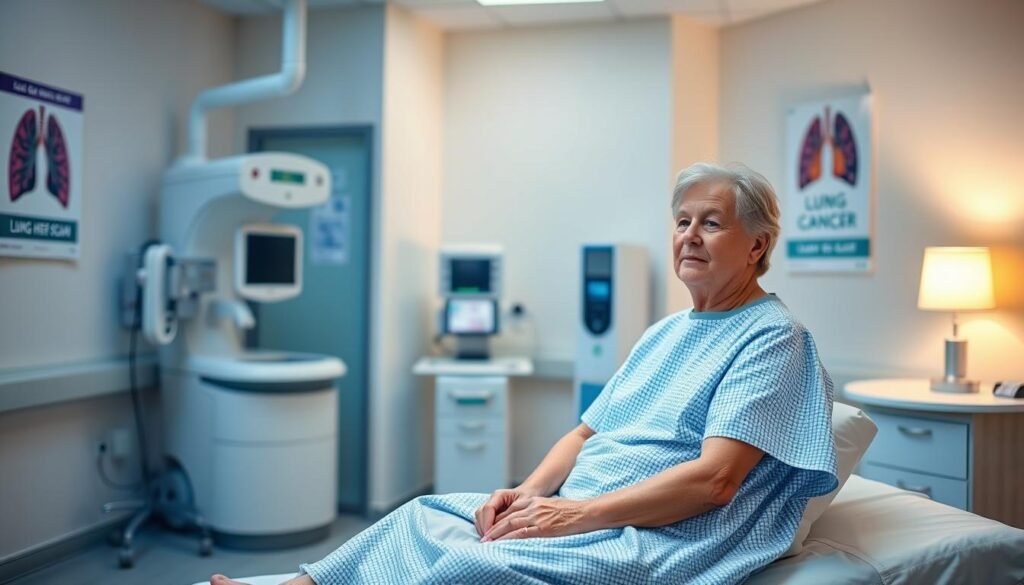Lung cancer leads in cancer deaths worldwide. It shows why finding it early is key. A low-dose CT scan (LDCT) helps catch cancer soon, improving chances of beating it. Everyone at risk should consider regular lung scans. This piece will talk about why lung scans are so crucial. Let’s take a step towards better lung health now.
Key Takeaways
- Lung cancer is the deadliest cancer in the U.S., emphasizing the need for early detection.
- Low-dose CT scans are crucial for identifying lung cancer before symptoms appear.
- Certain populations, such as smokers aged 50-80, are encouraged to get screened regularly.
- Early-stage lung cancer is more treatable, leading to better survival rates.
- Understanding pack-year history is essential for determining eligibility for screening.
- Being proactive about lung health can save lives through early diagnosis.
Understanding Lung Cancer and Its Risks
Lung cancer is serious, especially in the United States. Many people are affected by this disease. It’s very important to know what increases the risk. People who smoke or have smoked need to be careful. They should get checked for lung problems often.
Statistics on Lung Cancer
Lung cancer causes the most cancer deaths in the U.S. It is also very common, just after skin cancer. This year, about 236,740 Americans might get lung cancer. Sadly, around 130,180 might die from it. These numbers show why finding cancer early is important. Early detection means better chances of treatment working.
Common Risk Factors
Here are the main things that can make lung cancer more likely:
- Tobacco Smoking: Smoking causes most lung cancers. It’s the biggest risk.
- Secondhand Smoke: Being around smoke can also be harmful.
- Previous Lung Diseases: If you’ve had lung problems before, you might be more at risk.
- Chemical Exposure: Working with certain harmful chemicals can increase your chances.
- Family History: If lung cancer runs in your family, you could be more likely to get it too.
It’s important to keep an eye on your health. Knowing these risks can help you take better care of yourself. It’s also why getting checked regularly is key.Learn more about lung cancer detection.
Importance of Early Detection
Understanding early lung cancer detection can lead to proactive health steps. It enhances treatment and improves survival chances significantly.
Why Early Detection Saves Lives
Early lung cancer detection is crucial for survival. At Stage I, there is a 63% chance of surviving beyond five years. As the disease advances, survival rates drop, showing why regular screening is essential for at-risk individuals.
Sadly, only 21% of lung cancers are found early. This shows we need more awareness and screening.
Statistics on Survival Rates
Early action drastically affects survival rates. Recent studies have shown:
- People aged 50 to 80 with a 20 pack-year smoking history should get yearly screenings.
- Low-dose CT scans are advised for some, lowering lung cancer death risk by 20-25% over regular chest x-rays.
- Still, less than half who should get these screenings actually do.
Focusing on early detection can greatly boost lung cancer survival rates. It encourages people to take steps towards a healthier future.
The Role of Lung Cancer Screening
Lung cancer screening helps us find cancer early, before symptoms show. It mainly uses low-dose computed tomography (LDCT). LDCT is different from chest X-rays, which aren’t as good at finding early cancer.
LDCT scans are great at spotting cancer early. This increases the chances of beating cancer by starting treatment sooner.
How Screening Works
Low-dose CT scans are used to look for lung cancer. They can find very small growths in the lungs. This has cut down deaths from lung cancer.
Thanks to these scans, many cancers are found early. This is better than waiting for symptoms or using just X-rays.
Difference between Screening and Diagnosis
Screening and diagnosis are not the same. Screening checks for cancer before there are any signs. It uses special tests to find cancer early in people without symptoms.
Diagnosis happens when there are symptoms of disease. At this point, the disease might already be there. Understanding this difference helps give the right care at the right time.
Lung Cancer Scan: The Low-Dose CT Advantage
A low-dose CT scan is a special test to check for lung cancer using less radiation. Unlike normal CT scans that use about 7 millisieverts (mSv) of radiation, this uses only about 1.4 mSv. This makes it a safer option for checking for lung cancer.
What is a Low-Dose CT Scan?
The low-dose CT scan is quick and does not hurt. It takes many pictures of the lungs to find any tumors or problems. Studies, like the NELSON trial, show it reduces lung cancer deaths by up to 33% in women and 24% in men. The American Cancer Society says it could save 60,000 lives each year in the U.S.
Why it’s more effective than Chest X-Rays
Studies show low-dose CT scans are better than chest X-rays for finding early lung cancer. X-rays often miss small tumors, leading to late diagnoses. In contrast, low-dose CT scans can find cancer earlier, which reduces the risk of death. The National Lung Screening Trial found it resulted in fewer deaths from lung cancer than chest X-ray screenings.

People who should get a low-dose CT scan are those aged 50 to 80 who smoked a lot in the past or still smoke. The U.S. Preventive Services Task Force suggests they get checked every year. Keeping up with these screenings is important for both finding problems early and peace of mind.
Telling people about low-dose CT scans and how they’re better than X-rays can improve health results. Those looking for more info on this screening can click here.
Eligibility Criteria for Lung Cancer Screening
It’s important to know who needs lung cancer screening for early detection. The U.S. Preventive Services Task Force sets guidelines. These focus on a person’s smoking history and health. They help find those at high risk of lung cancer.
Who Should Get Screened?
People 50 to 80 who smoke or quit in the last 15 years should get checked yearly. They need at least a 20 pack-year smoking history. This plan aims at adults at high risk but in good enough health for treatment. Screenings stop at 81 or if someone hasn’t smoked for 15 years.
Understanding the Pack-Year History
A pack-year history tells if someone can get screened. It’s found by multiplying packs smoked daily by smoking years. For example, one pack a day for 20 years equals 20 pack-years. Two packs a day for 10 years is also 20 pack-years. This helps doctors spot those more likely to get lung cancer. Learn more here.
Benefits of Lung Cancer Screening
Lung cancer screening offers many benefits that can greatly affect patient outcomes. It goes beyond regular health checks. It allows for early treatments that can greatly boost survival rates. Knowing these benefits helps people, especially those at risk, to put their health first with timely screening.
Enhanced Early Detection Rates
Lung cancer screening’s major benefit is its boost in detecting cancer early. Research shows that it can find more than half of lung cancers early on. This makes treatments more successful and even curative. Without screening, only about 25% of cases are caught early for the best results.
Potential to Save Lives
Lung cancer screening can save lives by catching cancer early. Data from the National Lung Screening Trial shows screening can lower lung cancer deaths in high-risk people. Screening using low-dose CT can cut death rates by roughly 16% compared to chest X-rays. Plus, health insurance often covers these scans for those who qualify, making this life-saving test more accessible.

| Statistic | Without Screening | With Screening |
|---|---|---|
| Early Stage Detection | ~25% | Over 50% |
| Five-Year Survival Rate (Localized Cases) | 17% | 52% |
| Reduction in Mortality Rate | 0% | 16% |
Regular lung cancer scans lead to a better-informed health journey. They lower the risk of a late-stage cancer diagnosis and boost the chances of successful treatment. Getting high-risk folks to screen aligns with health goals to lessen lung cancer’s impact.
Possible Risks and Considerations
Lung cancer screening can offer big benefits, but it’s not without risks. It’s key to think about these before going ahead. Screening comes with radiation exposure risks and might give false positive results.
Understanding Radiation Exposure
Screening with low-dose computed tomography (LDCT) involves less radiation than regular CT scans. LDCT uses up to 90 percent less. Still, any radiation exposure has potential risks. This is true especially with several screenings over time.
False Positives and Further Testing Risks
False positives are tests that wrongly indicate cancer. They can lead to unneeded extra tests and stress for patients. From the National Lung Screening Trial, about 1 in 4 people got false-positive results after three years of screening. These tests can be expensive too, ranging from $6,320 for small issues to $56,845 for big problems.
Talking to healthcare providers about these risks is crucial. Knowing both the good and bad sides helps people make better choices about their health.
How to Prepare for Your Lung Cancer Scan
Getting ready for a lung cancer scan can make the process better. It helps to know what the lung CT scan involves and how to care for yourself afterward.
What to Expect During the Procedure
The lung CT scan is simple and quick. Usually, the scan itself is less than a minute. But, you might be there for up to 30 minutes. You’ll lie on a table that goes into the scanner. Staying still is key for clear images.
This low-dose scan is good for spotting lung cancer. Doctors look at 2D and 3D images to find issues like lung nodules. You don’t have to change your diet before the scan. But, take off jewelry and glasses first.
Post-Scan Considerations
After the scan, watch for any reactions, mainly if they used a contrast agent. Talking with your doctor quickly about the results is important. Places like Fox Chase Cancer Center might give results the same day. This lets you know what’s next right away.

Accessing Lung Cancer Screening Services
Finding lung cancer screening services early can save lives. To begin, find an accredited facility specializing in these screenings. These places use the newest CT scans. They also have staff who know a lot about lung cancer.
Finding Accredited Facilities
Quality screenings come from accredited facilities. Look for a few things when choosing one:
- Choose facilities recognized by top organizations.
- Make sure the staff is trained in lung cancer screening.
- Check for the latest scanning technology, like LDCT.
Talk to your doctor about finding a good place for you. Some locations offer special care for groups like veterans. They understand their specific needs.
Insurance Coverage and Medicare Options
The details about paying for lung cancer scans can be tricky. Medicare might cover the cost for some people. But, they need to meet certain conditions, including:
- Being ages 50 to 77.
- Having a heavy smoking history.
- Getting a doctor’s order for LDCT screening.
Usually, you’ll need to talk about the risks and benefits first. It’s crucial to talk with your doctor about payment options and coverage. Special codes are there for help with quitting smoking. It shows the need for a joint effort in care for those at risk.
Conclusion
Early lung cancer detection improves health outcomes for those at risk. Every two minutes, someone in the U.S. is diagnosed with lung cancer. This underlines the need for low-dose CT scans, which can cut death rates by 20%.
Last year, only 16.0% of at-risk people got screened. This shows a big gap in awareness about lung cancer screening.
The rules on who should get screened are clear. They focus on age and smoking history. People between 50-80 years old who have smoked for 20 years are seen as high-risk.
If more people in this group got screened, we could save lives and money. About 500,000 more years of life could be saved. This could also mean savings of about $500 million.
By promoting lung cancer screening, we can bridge the gap. Regular screenings can detect cancer early. This improves survival rates and lessens the disease’s impact. For more info, check out detailed lung cancer screening guidelines.